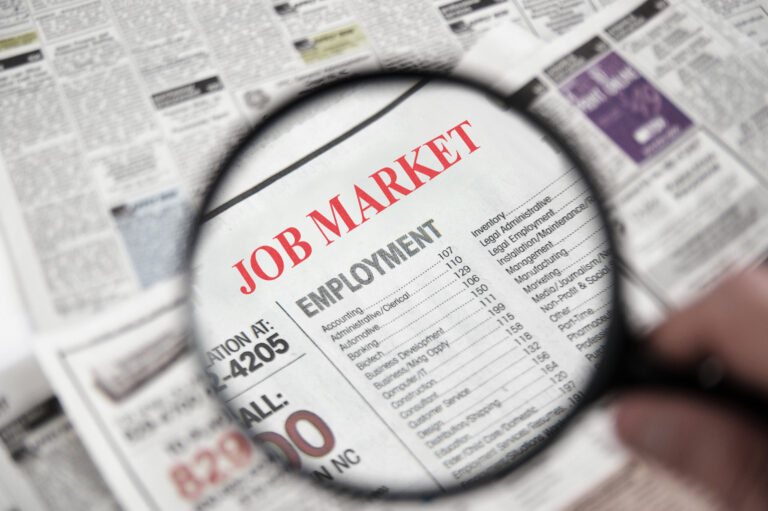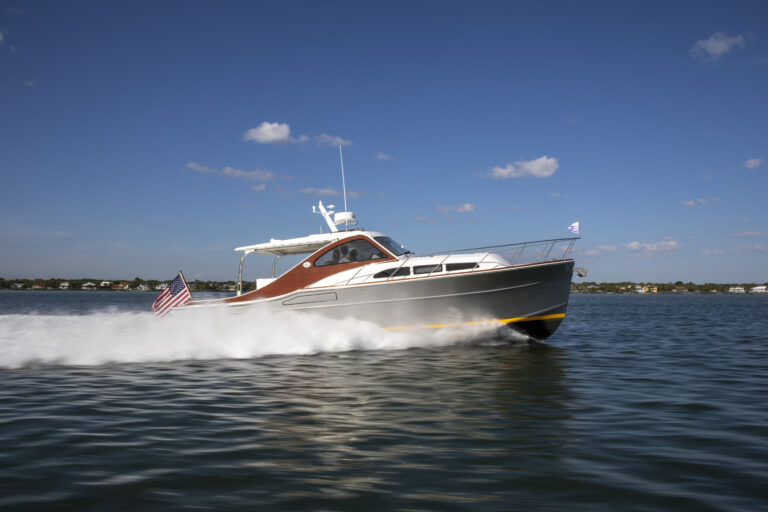Businesses are split on whether it’s easier to meet EPA regulations with an in-house guru or an outside environmental consultant

A few years ago, Jim Hardin added federal environmental regulations to his job description.
“There’s a lot of paperwork involved,” said the compliance manager in charge of health and safety for Grady-White, but “if you have a good system internally, it makes it a lot easier and a lot less time-consuming to do the reports.”
But many other companies turn to outside consultants who can stay abreast of ongoing environmental regulations and who have the expertise in tracking and monitoring them. Some say it’s cheaper to outsource than to hire a full-time employee and pay a salary and benefits.
In 2001, the Environmental Protection Agency mandated that boat manufacturers emitting more than 10 tons of Hazardous Air Pollutants adhere to the Maximum Achievable Control Technology (MACT) standards.
“What the EPA does is not bad for our business, but it’s challenging,” Hardin says.
The new mandate had to be met by 2004 and, as a result, record keeping and reporting of Hazardous Air Pollutants (HAP) emissions became even more tedious.
Four years later, companies have been charged with keeping track of and minimizing all hazardous emissions. As a result, boatbuilders have found different ways to deal with the mandate.
“We see a lot of outsourcing because … there is a lot of paperwork involved,” says John McKnight, director of environmental and safety compliance for the National Marine Manufacturers Association. Before Title V permitting, which limits factory emissions, companies did not have to keep track of air emissions.
The Title V permit of the 1990 Clean Air Act Amendments requires plants to set limits on air emissions and companies to pay fees for the permits, plus additional fees, which are based on emissions. Also, companies must monitor their emissions, keep records and adhere to the reporting requirements.
Companies such as Grady-White have been involved in the EPA’s process of implementing regulations and were basically prepared for the changes; Hardin was able to roll the new requirements into his existing job without too much hassle.
Other companies decided not to become as well-versed in the pages and pages of reports and data spreadsheets required by the regulations. Instead, those companies outsourced the work to consultants.
A few small companies tried to fly under the EPA’s radar, according to Kelly DeBusk, who started a business called Composites Compliance LLC to help companies become compliant with MACT standards.
“Unfortunately, a lot of my work comes after they [companies] have been affected and threatened with fines,” DeBusk says. “Even if they are aware they need permits, they try to get away with it until they get caught, and a lot of people just aren’t aware they need the permits.”
Those tend to be companies that emit less than 10 tons of HAPs, DeBusk says. But even so, most states now require a synthetic minor source permit.
“My suggestion for even small companies is you should be permitted,” DeBusk says. “A lot of states will issue a registration, but you should go to the state and get a permit to protect yourself.”
Ignorance does not help companies avoid heavy fines for operating without or outside of a permit, DeBusk said. Those can run anywhere from $10,000 to $25,000 per violation and can be applied each day a company is out of compliance.
Exceeding the emissions regulations isn’t the only fine-worthy violation — builders must also meet all the reporting deadlines.
“Definitely the regulatory side, it’s getting tougher and tougher,” says Dennis Pearson, who is the inhouse environmental director for US Marine/ Bayliner, a division of Brunswick.
Environmental rules get increasingly specialized, said Paul Zawila, owner of Value Environmental, a consulting business in South Carolina.
“The requirements continue to grow,” Zawila says. “When you compare what facilities have to do now versus five years ago, I think generally what you’re going to see is there’s more and more they have to do each year.”
The state oversees the federal and state regulations, which are always as stringent as or more stringent than EPA regulations. The state must ensure businesses are calculating correctly, and doing so on a weekly or monthly basis as outlined by the permit, Pearson said.
“If you’re not going according to the exact requirements, it’s the same penalty as if you went over in your emissions,” Pearson says. “The biggest issue is that the penalties can be issued without a company even knowing they are out of compliance. It can cost an enormous amount of money.”
Forgetting to change a filter one day or forgetting to document a special gallon of gel coat on another can cost hundreds of thousands of dollars in fines, Pearson says.
“We haven’t been fined on any of those things yet, but a lot of other companies have been,” Pearson says.
The choice to outsource
Fountain Powerboats assigned the huge EPA compliance task to engineering manager David Hardison four years ago after getting slapped with a fine for a late report. The initial $25,000 fine was reduced, but Fountain had to make some changes.
The new ventilation system cost $800,000, and Hardison now spends nearly $1,500 a month to have Value Environmental track and monitor permitting and compliance issues. But that’s much cheaper than hiring somebody to oversee the EPA compliance full-time, Hardison said.
“It would be a full-time job,” Hardison says. “To even understand it, you’ve got to be pretty well-versed; that’s why I hire someone from outside.”
It is up to the boatbuilder to report each time his company goes outside permitted regulations, Pearson says. For example, “if you’re going down the freeway and the speed limit is 70 miles per hour, and you go 71, you have to call the state trooper and report that,” Pearson said.
Staying on top of all the stipulations is difficult, Pearson agreed, which is why some choose to use consultants.
“It’s hard to justify a full-time person, and consultants are more up-to-speed on regulatory issues because they do that on a daily basis,” Pearson says.
Hiring a full-time person can have other drawbacks, says Zawila of Value Environmental.
“That person has to get up to speed over time, then you have turnover and then that expertise walks out the door,” Zawila says. “I think that’s why we’ve had success; they [companies] pay to retain us at a fraction of what that hire would cost them.”
A full-time EPA employee would be a big cost, DeBusk says. But given the stringent rules, at the very least, companies will have to pay consultants when monthly reports are due — by most MACT standards.
DeBusk says her services are less expensive than most in the industry; she charges $60 an hour. It takes about 10 hours a month, on average, to keep a company’s records in order, depending where the company is located, the type of permit and how the permit is written.
Permits can be tricky
Standards vary from region to region. New Jersey and Pennsylvania are following California’s stringent lead on emission standards, DeBusk says.
Keeping a California company compliant takes at least double the hours, says Zawila of Value Environmental. “There are a lot more rules on the books, and there is more you have to do out there,” Zawila says.
In Bayliner’s North Carolina plant, usage of hazardous pollutants is measured every day instead of monthly like in most states, Pearson says.
“In North Carolina you’ve got to go out on a daily basis and record how much of everything you used that day,” says Pearson of US Marine/ Bayliner.
Not only do rules vary by state, they vary by company too, Zawila says. “It depends on what rules apply to each facility, and it depends on the state’s rules.”
Companies, such as Grady-White and Bayliner, which have full-time employees to track and monitor environmental regulations, typically develop software programs and spreadsheets to help crunch the numbers needed to file the environmental reports.
The cost of doing business
No matter how companies deal with the standards, it comes at a price.
“For a small company, it’s a big overhead for something they never had to pay for, so how do you justify it, especially when your operation really hasn’t changed at all in the last 20 years?” says Pearson of US Marine/ Bayliner. “Now all of a sudden you have all these regulatory conditions you have to meet and document those conditions.”
Part of DeBusk’s job is figuring out how to get a company in compliance for the least amount of money.
“Smaller companies could have problems switching over all of their equipment at once,” DeBusk says. “Sometimes even the lower HAP materials are more expensive.”
But the standards set forth are achievable, DeBusk says.
“There might be an initial hit, but it’s more cost-effective in the long run,” DeBusk says. By lowering emissions, more of the materials end up in the product rather than going into the atmosphere, making the company more efficient.
And there’s little choice in meeting the standards. Hefty fines that could be imposed more than outweigh the cost of complying.
You have to comply, Hardison of Fountain Powerboats says of companies that would be tempted to skirt regulations. “You can’t hide it but for so long. The state comes in every quarter and does their inspections.”
The standards have benefits, Hardin of Grady-White says.
“We’re in the boating business, I think it’s important for our customers and for our industry as a whole to have the cleanest air and cleanest water we can have,” Hardin says. “We’ve got to do that in way that’s good for the environment and in a way that allows us to be successful as business owners.”
This article originally appeared in the June 2008 issue.











